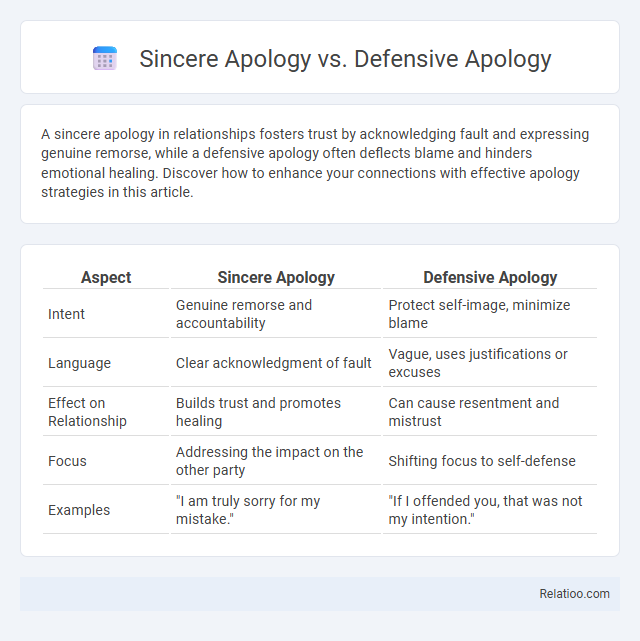A sincere apology in relationships fosters trust by acknowledging fault and expressing genuine remorse, while a defensive apology often deflects blame and hinders emotional healing. Discover how to enhance your connections with effective apology strategies in this article.
Table of Comparison
| Aspect | Sincere Apology | Defensive Apology |
|---|---|---|
| Intent | Genuine remorse and accountability | Protect self-image, minimize blame |
| Language | Clear acknowledgment of fault | Vague, uses justifications or excuses |
| Effect on Relationship | Builds trust and promotes healing | Can cause resentment and mistrust |
| Focus | Addressing the impact on the other party | Shifting focus to self-defense |
| Examples | "I am truly sorry for my mistake." | "If I offended you, that was not my intention." |
Understanding Apology: Sincere vs Defensive
A sincere apology demonstrates genuine remorse for your actions and acknowledges the impact on others, fostering trust and healing. Defensive apologies often include excuses or justifications that minimize responsibility, which can undermine the sincerity and effectiveness of the apology. Recognizing the difference allows you to repair relationships by offering meaningful apologies that validate feelings rather than deflect blame.
Key Characteristics of a Sincere Apology
A sincere apology involves taking full responsibility for your actions, expressing genuine remorse, and offering a clear plan to make amends, which fosters trust and healing. Defensive apologies often include justifications or excuses that diminish the fault, while deflection shifts blame to others, undermining the apology's effectiveness. Your ability to convey accountability and empathy defines the key characteristics of a sincere apology that truly resolves conflict.
Signs of a Defensive Apology
Signs of a defensive apology include language that minimizes responsibility, such as using qualifiers like "if" or "but," and shifting blame to external factors or the other person involved. The tone often feels insincere or forced, lacking genuine remorse, and may include justifications that attempt to excuse the offending behavior. Defensive apologies usually fail to acknowledge the impact of the action on the offended party, contrasting sharply with the genuine accountability found in sincere apologies and the avoidance seen in deflections.
Emotional Impact of Each Apology Type
A sincere apology conveys genuine remorse and accountability, promoting healing and trust restoration in relationships by validating the hurt feelings. Defensive apologies often minimize the impact of the wrongdoing and can leave Your emotions unacknowledged, leading to frustration and unresolved conflict. Deflection shifts blame away from the offender, exacerbating emotional pain and eroding the foundation of empathy and understanding essential for reconciliation.
Trust and Relationship Outcomes
Sincere apologies foster trust and strengthen relationships by demonstrating genuine remorse and accountability, which encourages forgiveness and open communication. Defensive apologies often undermine trust by appearing insincere or shifting blame, leading to unresolved conflicts and diminished relational satisfaction. Deflection erodes trust further by avoiding responsibility, causing frustration and damaging the bond between parties over time.
Language Patterns: Sincere vs Defensive Apologies
Sincere apologies use clear, unambiguous language such as "I am sorry for my mistake," reflecting accountability and empathy, directly addressing the issue without excuses. Defensive apologies include qualifiers like "if" or "but," e.g., "I'm sorry if you felt hurt," which shifts responsibility away from the speaker and minimizes the impact on the recipient. You can recognize these language patterns to differentiate genuine remorse from evasive responses, improving communication and conflict resolution.
Psychological Roots Behind Each Apology
Sincere apologies stem from genuine empathy and accountability, reflecting an individual's ability to recognize and take responsibility for their actions, which promotes trust and emotional healing. Defensive apologies are often driven by an internal need to mitigate personal threat or guilt without fully admitting fault, revealing underlying insecurity or fear of judgment. Deflection occurs when individuals redirect blame to avoid discomfort and vulnerability, rooted in a psychological defense mechanism to protect self-esteem and avoid confrontation.
How Sincere Apologies Foster Healing
Sincere apologies acknowledge responsibility and express genuine regret, fostering trust and emotional healing by validating the feelings of the aggrieved party. Defensive apologies often minimize the issue or shift blame, preventing genuine resolution and prolonging conflict. Deflection avoids addressing the core problem, hindering communication and damaging relationships by creating barriers to empathy and understanding.
Common Triggers for Defensive Apologies
Defensive apologies often arise from common triggers such as feeling attacked, fearing blame, or experiencing guilt, leading individuals to protect their self-image rather than genuinely acknowledge wrongdoing. Your ability to recognize these triggers can help differentiate between sincere apologies, which convey accountability, and deflective responses that shift responsibility away from yourself. Understanding these emotional catalysts enhances communication and fosters more authentic conflict resolution.
Transforming Defensive Apologies into Sincere Ones
Transforming defensive apologies into sincere ones requires acknowledging responsibility without shifting blame or minimizing impact, which fosters genuine empathy and trust. You can replace deflection phrases like "I'm sorry you feel that way" with specific statements addressing your role and offering a clear commitment to change. This approach enhances communication effectiveness and strengthens relationships by conveying authentic remorse and understanding.

Infographic: Sincere Apology vs Defensive Apology
 relatioo.com
relatioo.com